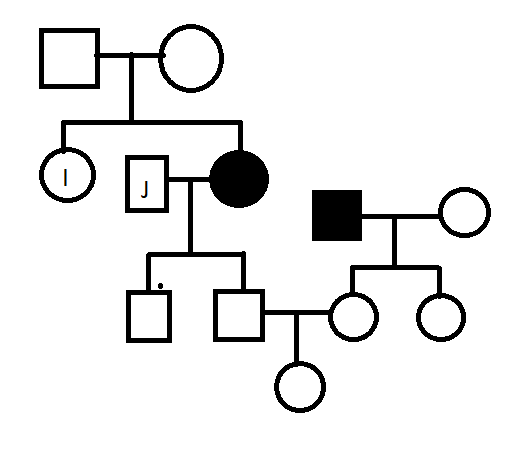Answer
370.8k+ views
Hint: A pedigree chart may be a graph that appears the event and appearance of phenotypes of a specific quality or living being and its precursors from one era to the another, most commonly people, appear mutts, and race steeds.
Complete answer: Using generic symbols, pedigrees reflect family members and relationships.
We may determine genotypes, classify phenotypes, and predict how a trait will be passed on in the future through the study of a pedigree. It is possible to decide how many alleles are inherited with knowledge from a pedigree: whether they are dominant, recessive, autosomal, or sex-linked.
Starting to read the pedigree:
-Determine whether the condition is recessive or dominant. If the trait is dominant, the trait must be had by one of the parents. A generation would not be missed by dominant traits. If the trait is recessive, because they may be heterozygous, neither parent is expected to have the trait.
-Determine if the graph indicates a characteristic that is autosomal or sex-linked (usually X-linked). In X-linked recessive traits, for instance, males are far more frequently impacted than females. Both men and women are equally likely to be affected by autosomal traits (usually in equal proportions).
-It is seen from the stated pedigree that generation II - 3 has the disease. It indicates that for the disease given, both parents are heterozygous (Zz). The 'I' may not have a disorder in the second century. This means that she has either homozygous dominant alleles (ZZ) or heterozygous alleles (ZZ) (Zz). She would have obtained Z alleles from each parent for the genotype ZZ.
-For the Zz genotype, she would have obtained either parent's Z allele and the other parent's z allele. There are, therefore, three options for parents to obtain alleles. Therefore, the probability of 'I' becoming a vector of disease Z is 0.67 and the probability of 'I' possessing regular alleles is 0.33.
Thus, choice A-0.67 is the correct one.
Note: In a family, the presence of many affected people does not necessarily mean that the trait is dominant. The terms dominant and recessive apply to the manner in which a character is presented, not how often it appears in a family. In fact, although it is rare, a feature can be recessive but still occur in a pedigree in all generations.
Complete answer: Using generic symbols, pedigrees reflect family members and relationships.
We may determine genotypes, classify phenotypes, and predict how a trait will be passed on in the future through the study of a pedigree. It is possible to decide how many alleles are inherited with knowledge from a pedigree: whether they are dominant, recessive, autosomal, or sex-linked.
Starting to read the pedigree:
-Determine whether the condition is recessive or dominant. If the trait is dominant, the trait must be had by one of the parents. A generation would not be missed by dominant traits. If the trait is recessive, because they may be heterozygous, neither parent is expected to have the trait.
-Determine if the graph indicates a characteristic that is autosomal or sex-linked (usually X-linked). In X-linked recessive traits, for instance, males are far more frequently impacted than females. Both men and women are equally likely to be affected by autosomal traits (usually in equal proportions).
-It is seen from the stated pedigree that generation II - 3 has the disease. It indicates that for the disease given, both parents are heterozygous (Zz). The 'I' may not have a disorder in the second century. This means that she has either homozygous dominant alleles (ZZ) or heterozygous alleles (ZZ) (Zz). She would have obtained Z alleles from each parent for the genotype ZZ.
-For the Zz genotype, she would have obtained either parent's Z allele and the other parent's z allele. There are, therefore, three options for parents to obtain alleles. Therefore, the probability of 'I' becoming a vector of disease Z is 0.67 and the probability of 'I' possessing regular alleles is 0.33.
Thus, choice A-0.67 is the correct one.
Note: In a family, the presence of many affected people does not necessarily mean that the trait is dominant. The terms dominant and recessive apply to the manner in which a character is presented, not how often it appears in a family. In fact, although it is rare, a feature can be recessive but still occur in a pedigree in all generations.
Recently Updated Pages
Basicity of sulphurous acid and sulphuric acid are

What is the stopping potential when the metal with class 12 physics JEE_Main

The momentum of a photon is 2 times 10 16gm cmsec Its class 12 physics JEE_Main

Using the following information to help you answer class 12 chemistry CBSE

Which of the following would not be a valid reason class 11 biology CBSE

Why should electric field lines never cross each other class 12 physics CBSE

Trending doubts
Difference Between Plant Cell and Animal Cell

Difference between Prokaryotic cell and Eukaryotic class 11 biology CBSE

Fill the blanks with the suitable prepositions 1 The class 9 english CBSE

Change the following sentences into negative and interrogative class 10 english CBSE

Write two gases which are soluble in water class 11 chemistry CBSE

Give 10 examples for herbs , shrubs , climbers , creepers

Fill the blanks with proper collective nouns 1 A of class 10 english CBSE

What organs are located on the left side of your body class 11 biology CBSE

The Equation xxx + 2 is Satisfied when x is Equal to Class 10 Maths




